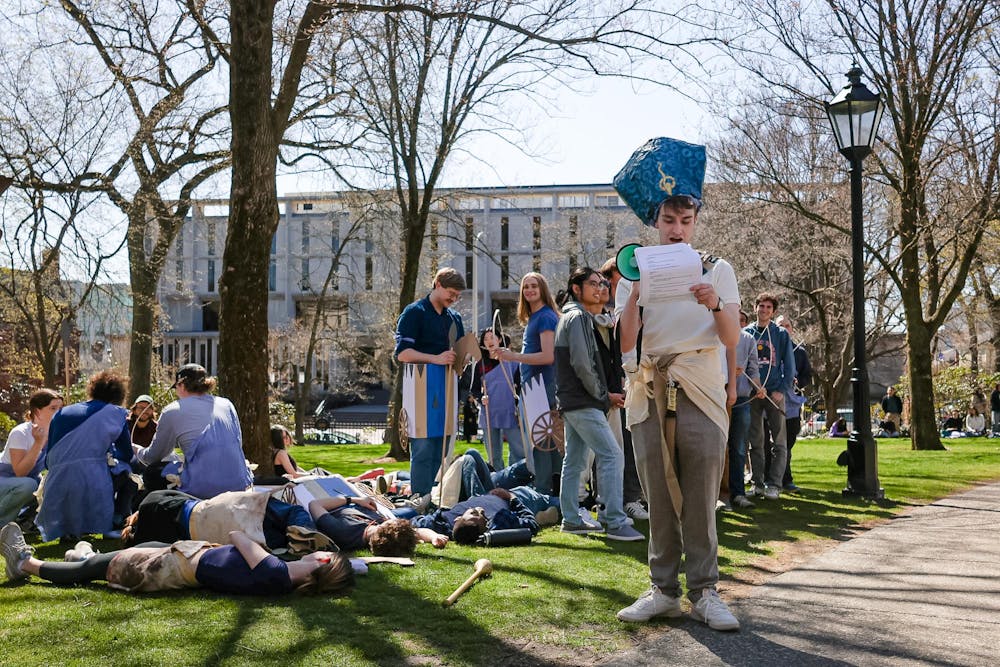“Charge!”
Within seconds of the bellowing call, the Quiet Green transformed into an ancient Egyptian battleground. Chariots were drawn, spears were stabbed and arrows were shot. Hordes of “soldiers” representing the Egyptians and the Hittites charged at each other, only to fall to the ground in mock death.
This Thursday afternoon clash was not real warfare. Instead, it was a reenactment of an ancient Egyptian battle organized by the 41 students in ARCH 1630: “Fighting Pharaohs: Ancient Egyptian Warfare.”
The reenactment was staged as part of the students’ final project in the course, according to course instructor Laurel Bestock ’99, an associate professor of Archaeology and the Ancient World, Egyptology, Assyriology and the history of art and architecture.
This year, students chose to reenact the 13th century B.C.E. Battle of Kadesh, a major battle between the Egyptian and Hittite empires. The battle, which took place along the modern-day Lebanon-Syria border, is believed to be one of the largest battles involving chariots.
Bestock makes the conscious choice to never teach the class “more than once per Brown generation,” meaning the last time the battle was fought on campus was in 2018, according to an email to The Herald.
“One of the reasons I love this assignment is because I kick it entirely to the students,” Bestock said in an interview with The Herald. “It’s always different, and they always own it.”
The battle opened with King Ramses II of Egypt — played by Wesley Horn ’28 — wheeling in on a handmade chariot to face off against the Hittite Empire.
King Muwatalli II of the Hittite Empire — played by Jitpuwapat Mokkamakkul ’25 — similarly rallied his troops into action to defend his rule over the city of Kadesh.
Though modern historians tend to agree that the original Battle of Kadesh ended in a stalemate, the students decided to end their reenactment with a peace treaty between the two empires.
“It’s very poignant that we’re choosing to end a battle with peace, especially with the current climate today,” Livia Hoffman ’25, who played one of the soldiers, told The Herald.
The real Egyptian-Hittite peace treaty was signed about 15 years after the Battle of Kadesh, and a copy of the treaty hangs in the United Nations Headquarters in New York City, according to Bestock.
Executing the live battle required a joint effort from the class, according to Horn. Students were divided into several teams responsible for scriptwriting, costuming, budgeting, logistics, choreography and prop making in preparation for the battle.
Although there was room for creative liberty — like the battle’s altered ending — research and historical documents played a significant role in shaping the final script, Hoffman said.
“A lot of our script writers took lines and quotes from monuments in Egyptian architecture and from these Egyptian records of the battle” and incorporated them into the reenactment, Hoffman added.
All of the chariots and weapons — including wooden spears, daggers and bows and arrows — used during the fight were handmade by the students in the class.
Many of these props were also inspired by historical sources. The chariot used to carry King Ramses II, for example, was based on a chariot found in the tomb of ancient Egyptian pharaoh Tutankhamun — commonly known as King Tut — and assembled from wood, metal parts and bicycle tires. To make the chariot, Samuel Kelemen ’25 and other students in the course had to learn how to weld.
Spectator Elise Petit ’25, who works as a Brown Design Workshop monitor, recalled seeing one of the student soldiers carving prop weapons in the BDW nearly every day.
But participation in the battle wasn’t exclusive to those in the course. Some audience members were provided weapons and invited to hop into battle.
For spectator-turned-soldier William Lu ’28, joining the battle “was a very spur-of-the-moment decision.”
“I was drafted into this terrible battle,” said Milo Akerman ’28, another audience participant. But Akerman’s foray into war was short-lived, as he was “killed” soon after joining.
“Before getting assassinated, it was really a period of great joy. I feel like I learned a lot about the cruelty of those in power,” Akerman said.
Reflecting on the event, Mokkamakkul was “impressed” by the class’s hard work.
Bestock expressed similar sentiments, highlighting both the comedic and academic aspects of the battle.
“To have (the students) bring both a scholar’s eye but also great humor to it was a really good choice,” Bestock said.





